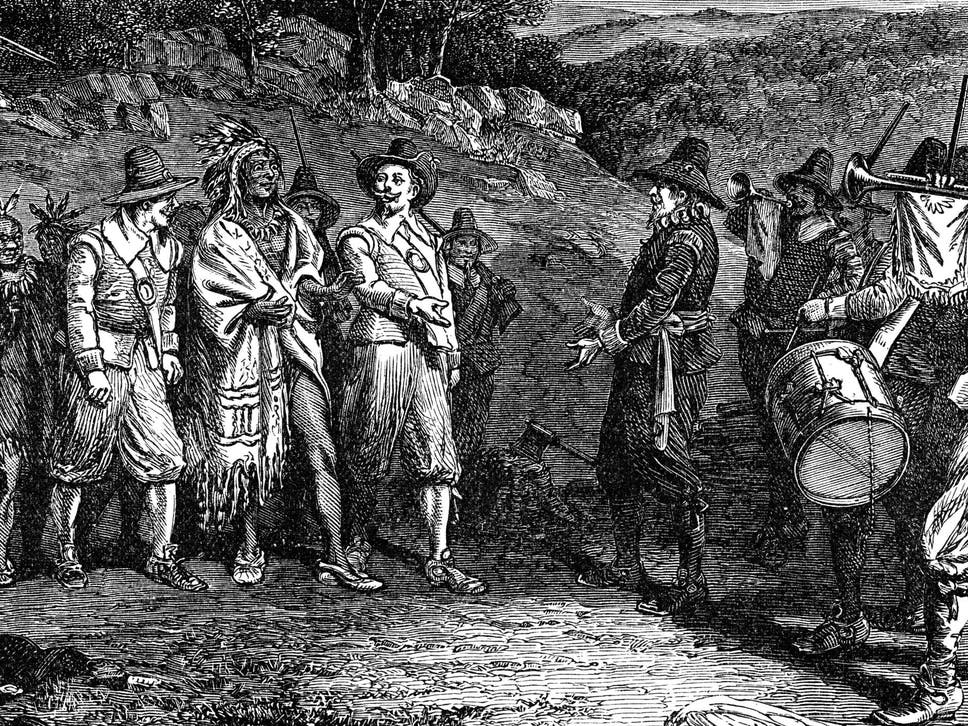
The Hill has the story: European colonizers's mass slaughter of Native Americans caused first major change in climate Excerpts in italics with my bolds.
A new study found that European colonizers who arrived in the Americas killed so many indigenous people that it caused the first major change in the Earth's climate.
The new study, conducted by researchers at the University College London, found that by killing nearly 56 million indigenous people over the course of roughly 100 years, European settlers caused large areas of farmland to go abandoned and reforest.
The study said the new swath of vegetated land, which CNN reported was roughly the size of France at the time, caused a massive decrease of in carbon dioxide (CO2) in the atmosphere then.
Levels of carbon in the atmosphere had changed so much that it caused the planet to experience a global chill in 1610, that is now known as the Little Ice Age, researchers said.
"CO2 and climate had been relatively stable until this point," UCL Geography Professor Mark Maslin, one of the co-authors behind the study, told CNN on Friday. "So, this is the first major change we see in the Earth's greenhouse gases."
Maslin told CNN that he and the team of researchers conducted the study by examining archaeological evidence, historical data and analyzing Antarctic ice, which can trap atmospheric gas and reportedly reveal the quantity of carbon dioxide that was in the atmosphere long ago.
He said a combination of all of the above showed researchers how the reforestation that was brought on by the mass slaughter of indigenous people in the Americas led to the global chill.
"The ice cores showed that there was a larger dip in CO2 (than usual) in 1610, which was caused by the land and not the oceans," Alexander Koch, the lead author of the study, told CNN.
"For once, we've been able to balance all the boxes and realize that the only way the Little Ice Age was so intense is … because of the genocide of millions of people," Maslin added.
Summary
There you have, all wrapped up with a bow on top. The Little Ice Age was caused by too little CO2, from too many trees because white men killed too many natives. Talk about connecting the dots. Did those white guys think they could get away with it? Thankfully, wildfires are solving the excessive forests problem. Oh wait.
From the Encyclopedia Virginia: The Little Ice Age and Colonial Virginia
The Little Ice Age refers to a period beginning about AD 1300 and lasting until the middle of the eighteenth century in which the average worldwide temperature may have cooled by as much as 0.1 degrees Celsius. Despite its name, this period "was far from a deep freeze," the scholar Brian Fagan, writing in 2000, has argued. "Think instead of an irregular seesaw of rapid climatic shifts, driven by complex and still little understood interactions between the atmosphere and the ocean." Some climate scientists contend that the term "Little Ice Age" is an exaggeration; others dispute the beginning and ending dates. (Historians have suggested that severe weather during the American Civil War may have been an effect of the Little Ice Age.) But nearly all agree that the seventeenth century—when the English founded the Virginia colony at Jamestown—was one of the coldest in the last thousand years.
The cause or causes of this cooling is subject to vigorous debate. Scientists have pointed to the Maunder Minimum, a period between 1645 and 1715 when the number of observed sunspots decreased, indicating a reduced level of solar activity; however, opponents of this theory argue that the resulting decline in solar irradiation was not sufficient to cause the Little Ice Age. During this cooling period, the tilt of the earth's axis also changed. Such changes may profoundly affect ocean circulation, which, in turn, affects climate. Still other scientists have suggested that volcanic eruptions—such as one in the southern Philippines in 1642—may have had an impact on the cooling, causing chemical reactions in the atmosphere that blocked or redirected sunlight.
The extreme weather wreaked terrible consequences on both the Indians and Europeans in Virginia. As the Spanish Jesuit pointed out, Indian populations decreased during times of drought, likely because of the scarcity of food. Such scarcities also led to conflict—among Indian communities and between the Indians and Europeans. The English at Roanoke had neither the intention nor the ability to feed themselves off the land, and a cold winter and drought conditions led them to place pressure on the Algonquian-speaking Indians of Ossomocomuck to share their already depleted supplies. This, in turn, led to warfare. Indian towns were destroyed and a weroance, or chief, beheaded.
While the Little Ice Age affected the entire world, leaving significant numbers of people to subsist on little food, its impact on Virginia was particularly sharp. It raised the stakes for both Indians and Europeans, making survival more difficult and conflict more likely.
Footnote: It seems once again, climatists have got cause and effect reversed.
from Climate Change Skeptic Blogs via hj on Inoreader http://bit.ly/2Bh1qzy
No comments:
Post a Comment